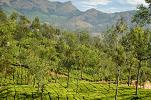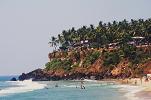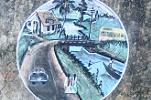|
|
Kerala History
An Overview of Kerala's Past
| An insight into Kerala history from the myths surrounding its beginnings to the first mention of the state in ancient texts. Covering the state's early contact with overseas traders and settlers, the years of colonial rule and the post colonial period up to the modern day. Kerala's coast has long been inundated with visitors, meaning that Kerala history is one flavoured by worldwide influences. These are reflected in the state's architecture, religious faiths, ideologies and culture even to this day. |
Origins In Mythology
| In Brahmin mythology (ancient and powerful Hindu caste, often teachers, priests and learned men) Kerala was created by Parasurama, a warrior and incarnation of the Hindu god, Vishnu. Parasurama is said to have freed the region of the oppressive Kshatriya kings and filled five lakes with their blood. Seeking penitence for his sins, he was told he must hand over the conquered lands to the Brahmins. At Gokarna he was blessed by the goddess of the earth, and when he reached Kanyakumari in southern India he threw his battle-axe northwards across the sea. The place where it landed rose from the sea and became Kerala. The legend may well stem from an earlier myth of the Chera Dynasty (ancient Dravidian-Tamil rule that pre-dates the Bahmin influence) in which the Chera King, Chen Kuttuvan threw his spear into the sea to claim the land. |
Pre-historic Kerala
Some of the first evidence of human habitation of the Kerala region is found in the dolmens (Neolithic tombs) of the Idukki district of present day Kerala.Evidence of Kerala's stone-age past can be seen in engravings at the Eddakkal Caves in Kerala's Wayanad district. These engravings lie on an ancient trade route and depict humans, animals, tools and writings that point to an advanced prehistoric people. The oldest of the engravings are thought to be 8,000 years old. |

Pandya and Chera Dynasties
| The Pandyan Dynasty was a monarchy that ruled large parts of south India (including southern areas of modern day Kerala) from as early as 550 BC. Southern India was referred to as Tamilakam and its language was Old Tamil. The Pandyas were one of four Dravidian-Tamil dynasties that ruled south India with varying influence until the the 15th Century AD. The Chera Dynasty ruled parts of modern day Kerala from around 300 BC. This was another of the four Dravidian-Tamil dynasties formed by the hunter tribe of Villavar. The Chera Dynasty held influence in the area until the 12th Century AD. Frequent fighting took place between the Cheras and the Pandyas but trade on the coast flourished. The west coast's lucrative spice trade was mentioned in the Sangam works (Pandyam literature dating from between 300BC to 300AD). Further evidence of extensive trade with this region comes from Arabic, Greek and Roman coins found near modern day Thrissur. Items exported included pearls, spices, ivory, timber and gems. In the 13th Century, Pandyan was described as the richest Empire in the world. |
Malayalam and Keralan Identity
Malayalam, Kerala's native language is thought to have developed between the 8th and the 14th Centuries and with it a distinct Keralite identity.
Settlers from Overseas
| West Asians have a long history of settlement and trade with the region of Kerala, and were often encouraged by local Kings to remain in the area for the benefits of trade ties. Jews started to settle in the region from around 500BC often seeking refuge from persecution. Christian settlers arrived throughout the ceturies following Christ and preached in the region. Ever increasing waves of Muslim traders introduced Islam to Kerala, and in the 7th Century AD and they began to settle the region and aquire influence on the coastal trade. Arab Muslim traders dominated the sea trade with Kerala from the 9th to the 15th Century, (though Arab trade in Kerala history dates back centuries). |
Colonial Rule
In 1498 Vasco da Gama famously arrived from Portugal in Kerala on a voyage which the Poruguese hoped would pave the way for disruption of the Arab monopoly on the Kerala spice trade. This began the colonial period of Kerala history. Da Gama was able to establish a fortress at Fort Cochin in 1503 and end Arab control over the spice trade. Conflicts between the local royal families of Calicut and Cochin enabled the Dutch to take control of the forts.The Dutch ruled coastal Kerala until attacks from various local kings and leaders of the region throughout the 18h Cenury weakened their control. The British were able to take control of the Malabar region in the 1790's following the Anglo-Mysore wars and treaties were formed with the leaders of Cochin and Travancore making these areas princely states of British India. |

Formation of Kerala as a State
| Throughout colonisation by the British conflicts were relatively uncommon. In the 1920s the riots of the Moplah rebellion brought Muslims and British into conflict. There were rebellions of allied local kings and leaders in the 1940s. In 1947 India achieved independence from the British, and the states of Kochi and Trivancore merged into one state in 1949. Kerala as an independent state was created on the 1st Novemeber, 1956 and elections were held in 1957. Following the 1957 elections, one of the world's first freely elected communist governments was formed in Kerala, and communist parties have held control of the Kerala Legislative Assembly (government of Kerala) frequently throughout Kerala history of the second half of the 20th Century. |
Kerala has a rich and ancient culture that has survived throughout years of overseas control on Kerala history. The guide to Keralan culture on this site details various important traditions of the region that are preserved and practised today.
More useful advice and guides for travel to Kerala.
^TOP^
Click here to leave Kerala History and return to Travel India Goa Guide Home
Kerala's Festivals -
Keralan Food -
Kerala Map -
Kerala Pictures -
Trivandrum Guide -
Fort Cochin

|
|
'Not to be missed' destinations of Kerala
Tea fields at Munnar

Incredible scenery and mountain air in Kerala's tea growing region.
Relaxing on Varkala beach

Varkala attracts worldwide travellers and though laid back, is well established on the backpacker trail.
Historical Fort Cochin

Enjoy the historic buildings, great food and bohemian ambience in Kerala's attractive Fort Cochin.
|
|








